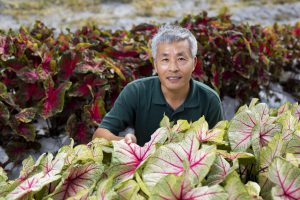Terri Bates knows that if she wants to sell a good caladium, she can count on University of Florida scientists, including Zhanao Deng.
“We grow 12 UF/IFAS varieties developed by Dr. Deng, and they are a huge asset to our business as well as the landscape/retail garden center industry,” said Bates, owner of Bates Sons & Daughters in Lake Placid, Florida.

The Sunshine State serves as the sole source of caladium bulbs for the world, and since 1976, UF/IFAS researchers have been breeding varieties of this ornamental.
Deng has developed 34 caladium varieties during his 20-year UF/IFAS career. Five of the most popular at nurseries are ‘Royal Flush,’ ‘Tapestry,’ ‘Fiesta,’ ‘Sizzle’ and ‘Lava Glow.’
‘Lava Glow is his most recent caladium. He describes it in a new UF/IFAS Extension document and in a new journal article.
The latest cultivar grows well in containers, and you can plant it in landscapes in sunshine or shade, said Deng, one of 31 UF/IFAS plant breeding faculty members across Florida.
“‘Lava Glow,’ with bright red to reddish-purple leaves, can further enrich the plant palette for caladium growers, nurseries, landscapers and gardeners. It’s an important addition to the red, fancy-leaved caladium variety group,” said Deng, a professor of environmental horticulture at the Gulf Coast Research and Education Center.
Great caladiums don’t grow on trees. Deng spends countless hours pairing the right parent plants to develop caladiums that nurseries and consumers will want.
“As a plant breeder, I am passionate about developing new cultivars that can satisfy needs of the environmental horticulture industry and consumers,” Deng said. “Caladiums can rival many flowers with their colorful, attractive leaves. They are easy to grow, and their color shows well for many months. That’s one reason so many people love caladiums, either in pots or the garden.”
Caladiums grow particularly well in Highlands County – about 60 miles south of Lakeland, in the heart of Florida. Deng calls the Lake Placid-Sebring area a “sweet spot” for producing caladiums. That’s because it has many months of frost-free weather, plenty of rain, fertile muck or organic soil.
The plant can suffer cold damage in the winter, but if the temperature stays above 60 degrees, caladiums can thrive.
###
ABOUT UF/IFAS
The mission of the University of Florida Institute of Food and Agricultural Sciences (UF/IFAS) is to develop knowledge relevant to agricultural, human and natural resources and to make that knowledge available to sustain and enhance the quality of human life. With more than a dozen research facilities, 67 county Extension offices, and award-winning students and faculty in the UF College of Agricultural and Life Sciences, UF/IFAS brings science-based solutions to the state’s agricultural and natural resources industries, and all Florida residents.
 0
0
